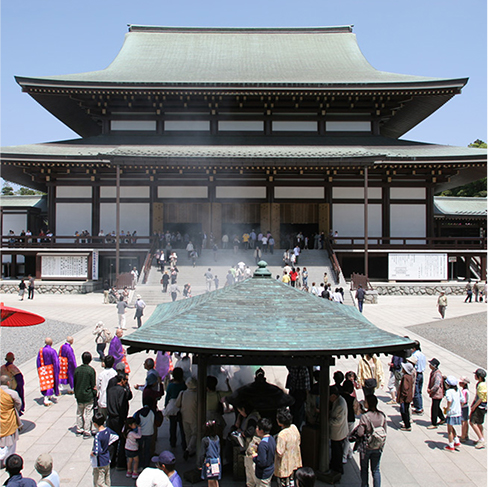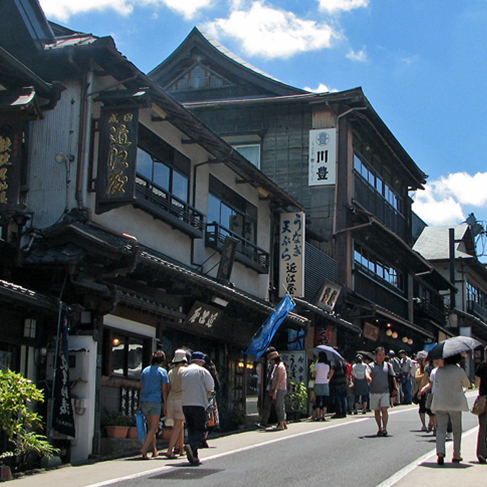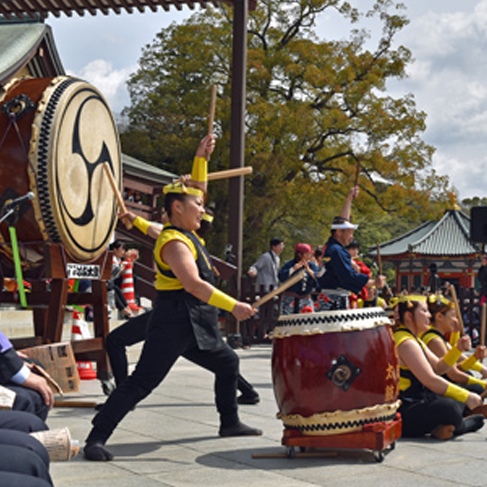
It is the text from here.
April 03, 2024
A holding place: Naritasan Shinshoji Temple and neighboring former Narita-cho
Origin of the Odori Hanami Dance
Odori Hanami Dance is performed every year in Saiwaicho, 7 ヵ-cho of Hanasaki-cho, Tamachi, Azumacho, book town, Nakacho, Kamimachi which formed former Narita-cho on April 3 in Narita. It was said that this Odori Hanami Dance was handed down from the Genroku era year, and it was appointed in Chiba intangible folk cultural properties in 1964.
 The meeting of women called the woman scheme (にょにんこう) is in each town, and the Odori Hanami Dance is performed by a woman scheme. According to annual relief turning around once in seven years, I gather in the Sannomiya Habu Jinja (Habu Shrine) which is a local deity of Narita, and 16 gods and Buddha worshiped in each town are visited to begin here, and the dance called the Maitreya (it is seen, and it is registered) dance is dedicated at each place.
The meeting of women called the woman scheme (にょにんこう) is in each town, and the Odori Hanami Dance is performed by a woman scheme. According to annual relief turning around once in seven years, I gather in the Sannomiya Habu Jinja (Habu Shrine) which is a local deity of Narita, and 16 gods and Buddha worshiped in each town are visited to begin here, and the dance called the Maitreya (it is seen, and it is registered) dance is dedicated at each place.
The woman scheme of seven former Narita-cho does the storage of "the basket" (= object of worship) in turn for one year. Because the woman scheme that storage of one year is over and delivered to the next woman scheme dances it out of joy freed from the responsibility on seasonal April 3 of cherry blossoms saying "it be done, and I sell, and it is done, and I hate it", it seems to be "Odori Hanami Dance". "A cherry blossom viewing dance" should be said if ordinary, but, from the place called "Odori Hanami Dance", it is revealed that a dance is important not cherry blossom viewing.
 "The Maitreya" of the Maitreya dance is the Goddess of Mercy based on the sacred book to relieve world all creatures of the degenerate age and is the faith that became popular from the around eleventh century in Japan. By folk dance distributed over the Izu area widely from Ibaraki, Chiba, Saitama region around a Kashima Shrine, the gods and Buddha are cheered up, and the Maitreya dance prays for plague breaking up and, by a dance to pray for rich harvest, the women of the woman scheme go around 16 Shinto shrines and Buddhist temples in seven in a matching kimono and pray and dedicate a dance.
"The Maitreya" of the Maitreya dance is the Goddess of Mercy based on the sacred book to relieve world all creatures of the degenerate age and is the faith that became popular from the around eleventh century in Japan. By folk dance distributed over the Izu area widely from Ibaraki, Chiba, Saitama region around a Kashima Shrine, the gods and Buddha are cheered up, and the Maitreya dance prays for plague breaking up and, by a dance to pray for rich harvest, the women of the woman scheme go around 16 Shinto shrines and Buddhist temples in seven in a matching kimono and pray and dedicate a dance.
Would all of you like to look at a spring dance to report a tradition by all means, too?
I come back to the top of the page
巡拝 course
It circulates through the gods and Buddha worshiped for each each town, but the circumference is different for each the town.
But the place where it is the Sannomiya Habu Jinja (Habu Shrine) that an opening is Chinju of Narita is common, and Odori Hanami Dance begins every year from from 7:00 a.m. to 8:00.
7:00-go part Habu Jinja (Habu Shrine)
Saiwaicho travelers' guardian deity
8:00 Saiwaicho Yakushi
The 9:00 Hanasaki-cho City Hall
Hanasaki Fudo Machimoto
10:00 Kamimachi travelers' guardian deity
11:00 Nakacho Atago (Narita Kankokan (Narita Tourist Pavilion))
12:00 book town Atago (believer Hall)
14:00 Naritasan main hall of a Buddhist temple Fudo
Naritasan fountain park (Okuyama)
Naritasan success in life Inari
Naritasan Kiyotaki Gongen-sama
Naritasan Dainichi Buddha
Naritasan Kourinkaku
16:00 Tamachi travelers' guardian deity, Atago
17:00 Azumacho Koyasu, 仙稲荷様
18:00 Hanasaki-cho Gongen-sama

Charm of Narita

Benefit spot & experience-based program full 成田詣 へいざ!

The Japanese central station which 100,000 people visit every day which is not the simple passage point

Naritasan Shinshoji Temple, Omotesando that is still full of worshipers in the old days

Narita holds various Events throughout the year
成田市観光協会 Copyright (C) Narita City Tourism Association. All Rights Reserved.
